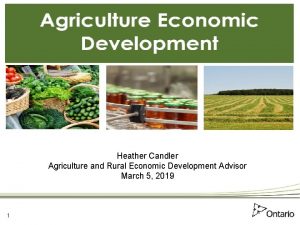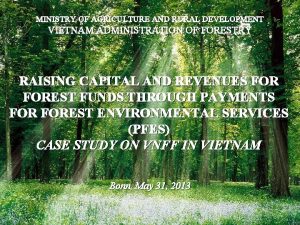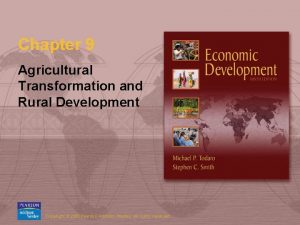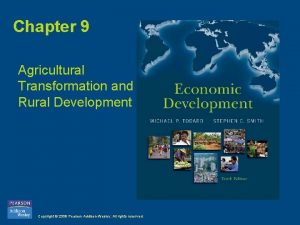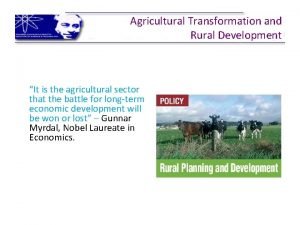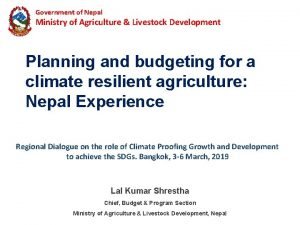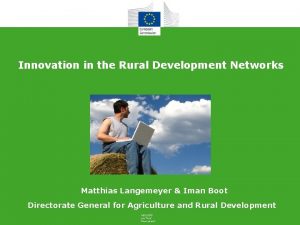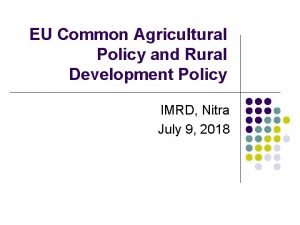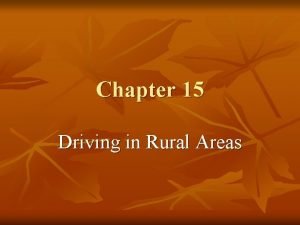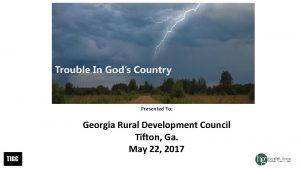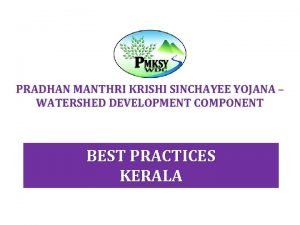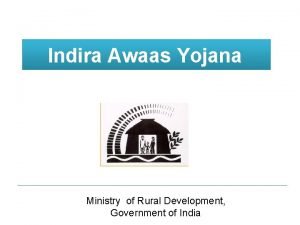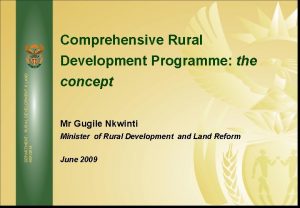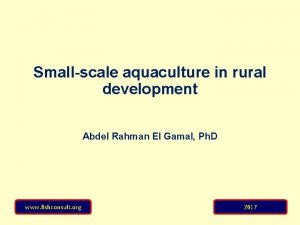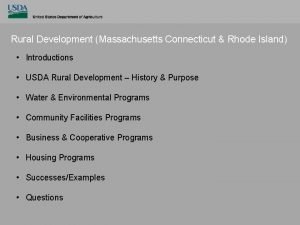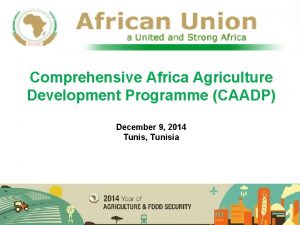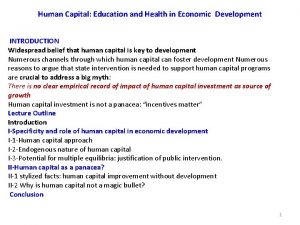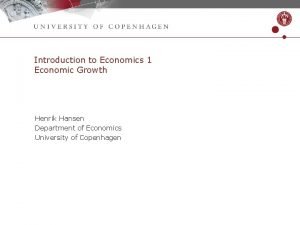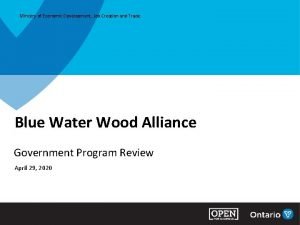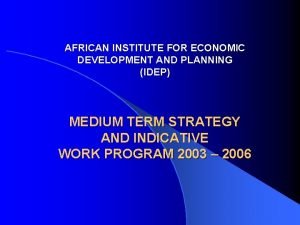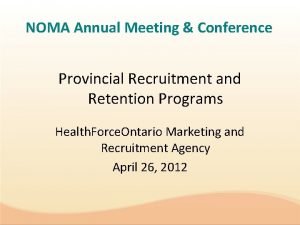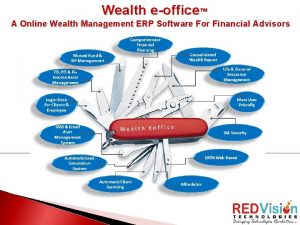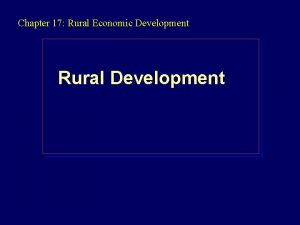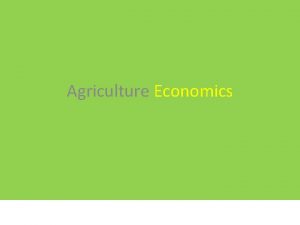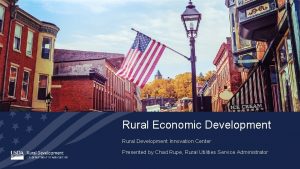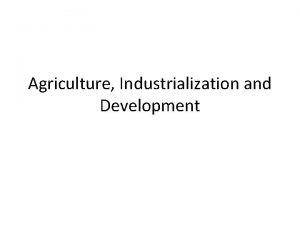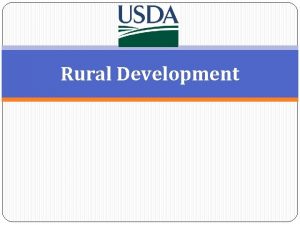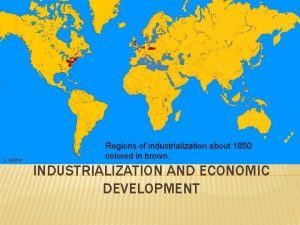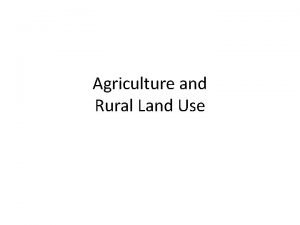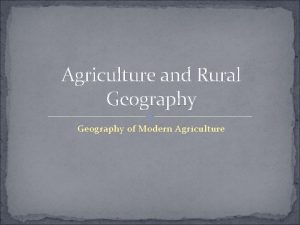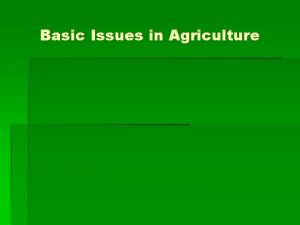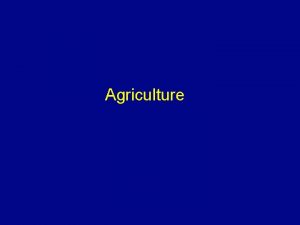Heather Candler Agriculture and Rural Economic Development Advisor
















































- Slides: 48

Heather Candler Agriculture and Rural Economic Development Advisor March 5, 2019 1

Agenda 2 • Overview of the Agriculture Economic Development resource guide • Share key agriculture economic development concepts • Introduce the range of agriculture economic development activities your community might explore

Agriculture & Food Economic Development • • 3 Traditional community economic development practices Actions are tailored and adapted to the agriculture / food sector

How Your Economy Works Money Coming Into Community Wealth Money Leaving Community 4

How to Grow your Economy 1. Bring in New Money • Attract/Start New Businesses • Expand Existing Businesses • Export Development • Encourage visitors to spend money in your community Community Wealth • Encourage people to live in your community 2. Plug the Leaks • Retain Existing Businesses • Buy Local Initiatives 5

Example of an Agriculture Value Chain (source: Northumberland County) 6

What could Ag & Food Economic Development look like in Haliburton County? • “Fostering the connection, growth, and sustainability of the ag / food sector, including primary agriculture, food processing, agriculture-manufacturing, and beyond (food retail, tourism, etc). ” • “Providing ag / food-related businesses with the tools, skills and networking opportunities to better themselves. ” • “Creating an administrative and economic environment where ag & food businesses can be profitable and grow. ” 7

8

The Role for Municipal Staff and Community Leaders • • • 9 Shifting municipal responsibilities in economic development Agriculture / Food Economic Development: not just a farmer’s or municipality’s responsibility - it takes a village! What types of activities can a municipality realistically take on?

Your Role in Agriculture Economic Development Promoter Connector Educator Enabler Organizer 10 127

Tips for Successful Agriculture Economic Development • • • 11 Visibly demonstrate the importance of the agriculture / food sector Build networks and capacity in the community Get people involved. Accurately assess the needs of the local agriculture sector Understand that agriculture and local food are about the long game Don’t give up easily – and celebrate small wins along the way.

Agriculture Economic Development: A Process for Change 12

13

Stage 1: Plant • • • 14 Assessing Community Readiness Building a Snapshot of Local Agriculture Identify and organize community leadership

What do you want to accomplish in the “Plant” stage? • • 15 Communicate the opportunity Build capacity in your community Foster buy-in from community leaders and your agriculture and food sector Lay a foundation for ongoing initiatives

Assessing Community Readiness • 16 How ready is your community to take on agriculture economic development?

Community Readiness • 5 attributes to Community Readiness: • • • 17 Knowledge and Awareness Leadership Collaboration Resources Engagement

17 18

Identify and Organize Community Leadership 19

Building an Agriculture Committee 20

Types of Committees Agriculture/Food Advisory Committees 1. • Provide advice and guidance to council and staff Agricultural/Food Action Committees 2. • Focus on the design and delivery of local initiatives What kind of committee might fit best in your community? 21

Terms of Reference • • • 22 Define the purpose of the committee Establish the mandate of the committee Set Parameters and Limitations of the committee Define Accountability and Structure for the Committee Define the time frame for the committee Determine resources required for the committee. Hanot

23

Stage 2: Grow • Get a sense of what is going on already in your community • • • Start a dialogue with your local agriculture sector • • • 24 Review community profiles Conduct agriculture system inventory exercise Surveys Focus Groups Interviews or 1: 1 phone calls

Review Community Agriculture Profile This statistical understanding can help: • Inform the upcoming agriculture asset inventory • Demonstrate knowledge/ credibility in conversations with agricultural stakeholders 25

Agriculture Systems Approach Land-use planning and economic development working together • • • 26 Protect Ag Land Protect Viability of Ag Businesses Protect access to a robust agrifood network (e. g. cold storage facilities, abattoirs, food processors, grain dryers)

Developing an Inventory of Your Agriculture System An inventory will help you identify and build on what you already have, and uncover potential opportunities for further development. There are three components: 1. Agricultural Land Base 2. Existing Agri-Food Network 3. Existing Initiatives 27

Agriculture System Asset Inventory Describe the Asset/ Infrastructure Assets and Infrastructure Who is Responsible? Gaps – What is Missing? Regional Infrastructure (e. g. roads, ports, grain dryers, cold storage facilities) Agricultural services and suppliers (feed mills, veterinarians, dealers) Distribution channels Processors (e. g. wineries, factories, abattoirs) Retail and Direct Sales Agricultural Partners 28

Data Sources that can support the Asset Inventory Data sources that can support this process include: • OMAFRA Agricultural Information Atlas • Census of Agriculture • OMAFRA Agricultural Census Maps • AAFC Soil Survey Reports • County Agricultural Profiles • County Business Profiles • OMAFRA Asset Mapping Tools • OMAFRA’s Analyst tool 29

Community Agriculture Survey Components: 1. Contact Information 2. “Boiler Plate” Information 3. Assessing Business Needs 4. Discussion Questions 30

Sample Community Agriculture Survey Strongly Agree Strongly Disagree Statements 1 2 3 4 Agriculture and agri-businesses are strongly valued in my community I work closely with other businesses along the agriculture value chain I source the majority of my supplies and/or products services locally Raising the profile of my business in the community is important to me I would like to source more local products to support my current business I would like to sell more product into the local community/ agri-food sector 31

Sample Discussion Questions 1. In your opinion, what are three greatest barriers to growing economic activity around agri -food in this region? 2. In what ways could local/regional organizations and municipalities assist in enhancing the agricultural economy? 3. What three community assets or infrastructure would you like to see developed to better support the agri-food sector? Please explain. 32

Interviews • • 33 Great opportunity for relationship building Can uncover issues of private concern Involves a set of questions structured around agricultural issues Questions can be posed in-person, over the phone, or using online platforms

Local Food First Impressions Community Exchange Don`t forget to revisit the findings of this important study when creating your profile! 34

35

Stage 3 – Harvest • • 36 Goals & Objectives Actions for Agriculture Economic Development Capacity Rankings Measuring and Reporting Outcomes

Prioritize and Select Goals 37 • Identify and focus efforts on three to five goals for the action plan. • Goals should be based on the critical opportunities identified in the previous stage. • Goals should be clear and are set for the long term. • A goal can be divided into a number of more specific and measurable objectives.

Strategic Planning Resource • • 5 step process A step-by-step process as well as resources and tools to assist with each stage. 39

Durham Region Local Food BR+E 5 Key Findings/Themes 40

Potential Activities 39 41

Potential Activities 40 42

Assessing Community Capacity 43

Low Capacity Activities 48 44

Medium Capacity Activities 45

High Capacity Activities 46

Measuring and Reporting Outcomes • • 47 Helps demonstrate and document changes over time Informs decision-making processes Increases accountability Performance Measures guide helps organizations understand, develop and benefit from the performance measurement process

Stay Connected: Agriculture Economic Development and Planning Community of Practice (AEDP Co. P) • • • 48 A forum for Ontario practitioners to promote best practices, share success stories, and build capacity Accessible, low time commitment, low cost Hear from experts and connect with peers Delivered in partnership with the Ontario Federation of Agriculture (OFA) For more information: www. ofa. on. ca/communityofpractice

Thank You! 49
 Agriculture
Agriculture Ministry of agriculture and rural development cameroon
Ministry of agriculture and rural development cameroon Ecotourim
Ecotourim Economic growth and development
Economic growth and development What were the policies implemented by roxas
What were the policies implemented by roxas Economic growth vs economic development
Economic growth vs economic development Chapter 9 agricultural transformation and rural development
Chapter 9 agricultural transformation and rural development Chapter 9 agricultural transformation and rural development
Chapter 9 agricultural transformation and rural development Agricultural transformation and rural development
Agricultural transformation and rural development Importance of agriculture economy
Importance of agriculture economy Ministry of agriculture and livestock development nepal
Ministry of agriculture and livestock development nepal Matthias langemeyer
Matthias langemeyer Rural development
Rural development Chapter 15 driving in rural areas
Chapter 15 driving in rural areas Usda rural development tifton ga
Usda rural development tifton ga Pradhan mantri krishi sinchayee yojana in kerala
Pradhan mantri krishi sinchayee yojana in kerala Ministry of rural development
Ministry of rural development Comprehensive rural development programme
Comprehensive rural development programme Conclusion of rural development
Conclusion of rural development Rural development officer
Rural development officer Rural development loan massachusetts
Rural development loan massachusetts Chapter 1 lesson 2 our economic choices worksheet answers
Chapter 1 lesson 2 our economic choices worksheet answers Agriculture development
Agriculture development Family and community health advisor
Family and community health advisor Human capital education and health in economic development
Human capital education and health in economic development Economic growth and development
Economic growth and development Swodf
Swodf African institute for economic development and planning
African institute for economic development and planning Hfojobs
Hfojobs Configurer proxy uqam
Configurer proxy uqam Uwb advising appointment
Uwb advising appointment Umr plan advisor
Umr plan advisor Unc charlotte ap credit
Unc charlotte ap credit Fidelity advisor 529 plan
Fidelity advisor 529 plan Ucdavis siss
Ucdavis siss Norco web advisor
Norco web advisor Tactical advisor police
Tactical advisor police Ics academic advising
Ics academic advising Hpe right mix advisor
Hpe right mix advisor Financial advisor for startups
Financial advisor for startups Wealth eoffice client login
Wealth eoffice client login Ucf
Ucf Recommended on tripadvisor
Recommended on tripadvisor Pdg advisor
Pdg advisor Sports compleat advisor
Sports compleat advisor Pcc academic advising
Pcc academic advising Academic advisor uf
Academic advisor uf Motor teknologi & industri sdn bhd
Motor teknologi & industri sdn bhd Qradar advisor with watson
Qradar advisor with watson
